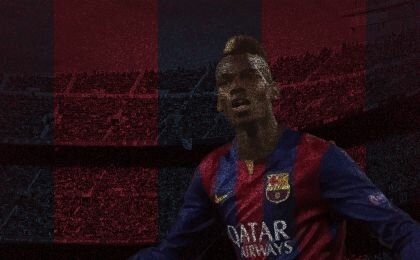 analysis | 2015-06-29
analysis | 2015-06-29
Aleix Vidal - Everything you need to know
Introducing the new signing
On any other day, Aleix Vidal’s signing and presentation as an FC Barcelona player is big news. But the news have been swept under the rug due to the timing and circumstances, with the whole culéverse still euphoric from winning the Champions League and a historical second treble.
Maybe the timing was intentional. It coincided with Bartomeu’s marathon of renewals: Dani Alves’, Luis Enrique’s, Pedro Rodriguéz’s and Jordi Alba’s. Some suspect that these are political rather than sporting decisions, designed to court votes for the upcoming elections. Either way, Aleix Vidal’s inclusion will be beneficial for the blaugrana team.
The Catalan is a signing that left many fans satisfied, as he is a very good player that can contribute to the team in a myriad of ways. Even though he can’t play until 2016, his former Almería coach Lucas Alcaraz says that won’t affect him: “If Aleix can’t play until January, he’ll train even harder. He’ll make the physical coach cry.”
Who is Alex Vidal, and why is he our first signing after the ban?
Aleix Vidal is a 25-year-old Catalan, born August 21, 1989 in the city of Valls just an hour-and-a-half away from Barcelona. His youth career started there as well, in UE Valls, which is a fairly new club founded in 1980.
After playing in UE Valls for one season, he went to the youth academy of FC Barcelona. He lasted only one season in the blaugrana colors, where he played mainly as striker based on videos of his time at the club. Aleix played in Barcelona’s U-13 team during the 2001/02 season together with Jordi Alba. Now, 14 years later, they reunite. Alba describes Aleix as “a player with a fantastic physical condition and who will fit in perfectly with Barça.”
His youth career is characterized by moving from one club to another; he changed clubs almost every other season, even joining Barcelona’s erstwhile rival Real Madrid. Vidal played for FC Cambrils (2002/03), Gimnàstic (2003/04), Real Madrid (2004/06), Reus (2006/07) and Espanyol (2007/08).
His senior career started when he got his first professional contract at Espanyol B in 2008. However, he didn’t play a single game for the club and was loaned out to the Greek team Panthrakikos in 2009, where he made eight appearances before being sold to the Catalan team Pobla Mafumet. Aleix continued playing in the lower teams, and later returned to one of his childhood clubs, Gimnàstic, but this time as a professional.
He joined Mallorca B the following season, but it wasn’t until two seasons later, in 2011, when things started to get interesting, when he joined Almería’s B-team. He didn’t play much for the B-side, but when he debuted for Almería’s A-team against Córdoba in 2011 he began to attract attention. Shortly afterwards he was promoted to the main squad, becoming a key player and helping his club avoid relegation. Aleix, who was a winger at the time, offered a lot of pace and was a skillful dribbler.
Aleix’s performances for Almería made many clubs sit up and take notice. A number of teams in Spain and in the Premier League showed interest, but he found Sevilla’s offer the most appealing. The fee for his transfer to Los Nervionenses, where he signed a four-year contract, was €3 million.
What does he bring to Barça’s play?
Even before he is allowed to play, Aleix Vidal’s arrival will mean that players like Pedro Rodríguez and Dani Alves, even if both players renewed their contracts recently, will have to work even harder to prove themselves for Lucho. When Aleix finally gets the chance to play, his addition will bring some changes to the mechanisms of the team and the way they function, both in attack and defense.
Given Xavi’s departure (taking his unique virtues with him), Lucho will most probably look for someone to fill in the void left by the Maestro by giving Ivan Rakitic a more central role. In his first season at the Camp Nou, the Croatian played in more or less an off-the-ball role, drifting wide for Messi and offering width and a safe forward-passing option in the second half of the season. One of Rakitic’s roles was also to cover defenders, leaving the space in the middle of the pitch for “La Pulga” to combine with Sergio Busquets or Dani Alves in order to create goalscoring chances.
With his pace, Aleix can, as he did at the service of Unai Emery, add to Barça's already great counterattacking game. Last season, Aleix started to play as a right midfielder, a winger if you like, but he has been pushed back in the last eight to nine games for Sevilla to play as a right back, and he really shone there, playing what was probably the best game of his career: in the first leg of the last Europa league semifinal vs Fiorentina at home, leading his team to a 3-0 win while scoring a brace and setting up another.
Starting as a winger and then getting pushed back to be a full back is a story he shares with Alba, who had the same experience when he was playing in Valencia. Coincidentally, it was Emery who converted both players to their “new” positions, a move that led them to rejoin Barça. This is not the only thing Aleix shares with Alba, there are also some aspects in his game similar to Alba’s; both are reliant on pace and especially hardworking.
Barcelona brought Aleix for €18 million plus €4 million in bonuses. The contract is good for five years, until 2020. The idea is to use him mainly as a right back, mirroring the pace and physicality of Jordi Alba on the left flank.
What are the available options for Aleix Vidal?
Barça will play the whole first half of the next season with only Rafinha Alcântara, Rakitic and Andrés Iniesta as choices in the central midfield position. Busquets, Sergi Roberto and Javier Mascherano are defensive midfielders and don’t fit the role. For these reasons, Alves is an option as a right-sided midfielder or an “interior” when Lucho rotates or in the event of suspensions and injuries. When this happens, Aleix is the logical replacement for Alves. This and other possible options for Aleix are found below:
1) As Dani Alves’ replacement at right back with Rakitic in central midfield
As mentioned above, Aleix is a quick player and he can provide Barcelona a more vertical role than the one Dani Alves has been playing. Alves was more involved in Barça’s ball circulation and construction phase and this role might be taken by Rakitic. In this scenario, Aleix will be the right back with Rakitic in midfield.
2) Right back with Dani Alves as right midfielder
There could also be a scenario when both Aleix and Alves are on the pitch: converting Alves to be a right-sided midfielder, especially during games to rotate Rakitic. Alves is more than ready to play that role given the tasks Rakitic has taken over last season and the way Alves has played that season, especially during the last two finals.
Alves has combined with Leo in central areas. When this happens, Aleix can provide the width.
Alves has put his pressing ability under more practice last season. In the Copa del Rey and Champions League finals, he made runs all the way to the middle of the pitch to press the ball, which is something he does with high intensity and elegance.
Of course, Alves still has to contribute defensively and support Aleix in Lucho’s 4-4-2 defensive shape, a system Lucho has used many times in his first season as a Barça coach.
As a winger in a 4-2-3-1 formation
In the second half at home after securing a 6-0 lead vs Getafe, Lucho experimented with a 4-2-3-1 formation after subbing Xavi off and bringing Pedro on, letting Messi play behind the attack-minded trio of Pedro, Suárez and Neymar. As he is originally a winger, Aleix would fit right in in this situation and take the role Pedro played in some matches last season. This doesn’t mean that the situation will become totally complicated for Pedro; the latter showed in the games against Sociedad and later versus Atleti, when Barça were crowned La Liga champions, that he can play as a mobile No. 9 for his link-up abilities and work rate, especially without the ball.
Aleix has scored six times from 30 shots and gave 11 assists for the Andalusians last season, but he knows what is expected of him in Barça. “I’m not likely to be needed up front,” Aleix said during his presentation. Playing as a winger to defend and keep things tight at the back in a 4-4-2 Lucho sometimes uses is a good option given that he has played as a full back, same as Pedro’s role at times, or Rafinha’s, in the last Clásico at the Camp Nou. Aleix has won 163 balls for Sevilla last season, an average of 3.5 per match.
We’ll see how Lucho will use Aleix, as there are many options given his versatility. Many of our players have adapted to the team and its conditions swiftly, and hopefully Aleix will be able to do that as well. How aware he is of the differences in style will be a crucial part of his performance.
For now, looks like everything is going well for Aleix even if he has to sit out at least four months before he can put on the Blaugrana shirt: last week, he played in his first international call up for Spain in the friendly against Costa Rica as a right winger.










